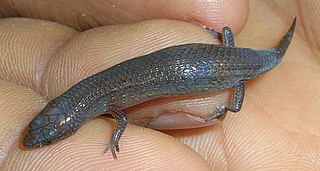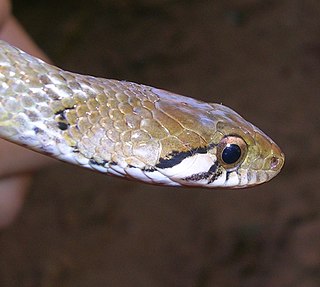
Ristella is a genus of skinks, lizards in the family Scincidae. The genus is endemic to the Western Ghats of southwestern India. Member species are commonly known as cat skinks because of their retractile claws. This genus can be instantly identified by the presence of only four fingers in forelimbs in all the species. All the members look more or less similar, and are drab dark brown to blackish in colouration, with paler undersides. This poorly known group of lizards is diurnal, insectivorous, terrestrial to semi-fossorial in habits. They inhabit deep leaf-litter and grasslands in montane forests and rainforests.

Agasthyagama beddomii, commonly known as the Indian kangaroo lizard, is a diurnal, terrestrial, insectivorous agamid lizard, endemic to the Western Ghats of South India.
Beddome's worm snake is a species of harmless blind snake in the family Gerrhopilidae. The species is native to southern India. No subspecies are currently recognized.

The Nilgiri keelback, also known commonly as Beddome's keelback, is a species of snake found in the Western Ghats in India. The species is named after Richard Henry Beddome, 1830–1911, British army officer and naturalist. It was first discovered near the Nilgiris but is now known more widely from the Western Ghats. This snake is terrestrial and feeds on toads.

The Indian golden gecko or Beddome's golden gecko is a species of gecko endemic to the Eastern Ghats of India. It was rediscovered from the hills near present-day Tirupati. The rediscovery was after over 100 years since its description.
Beddome's day gecko is a species of lizard in the Family Gekkonidae endemic to India.
Uropeltis beddomii, commonly known as Beddome's earth snake, is a species of snake in the family Uropeltidae. The species is endemic to India.

Uropeltis pulneyensis, commonly known as the Indian earth snake and the Palni shieldtail, is a species of snake in the family Uropeltidae. The species is endemic to the Western Ghats of India.
Uropeltis rubrolineata is a species of nonvenomous shieldtail snake in the family Uropeltidae. The species is endemic to southern India. There are no subspecies that are recognized as being valid.

Ophisops beddomei, commonly known as Beddome's snake-eye or Beddome’ s lacerta, is a species of lizard in the family Lacertidae. The species is a diurnal and fast-moving terrestrial lizard, which is endemic to the Western Ghats of India.
The minor snake-eyed skink is a species of lizard in the family Scincidae. The species is native to Asia.
Vosmer's writhing skink is a species of skink, a lizard in the family Scincidae. The species is endemic to India.
Eutropis beddomei, commonly known as Beddome's mabuya or Beddome's skink, is a species of lizard in the family Scincidae. The species is native to India and Sri Lanka.
Ristella guentheri, commonly known as Günther's ristella and Gunther's cat skink, is a species of lizard in the family Scincidae. The species is endemic to India.

Ristella rurkii, commonly known as Rurk's ristella, is a species of skink endemic to the Western Ghats of southern India. It is a small, insectivorous, diurnal skink found in shola grasslands and rainforests of hills ranges in parts of Tamil Nadu and Kerala states of India.

Ristella travancorica, commonly known as the Travancore cat skink or the Travancore ristella, is a species of skink endemic to the Western Ghats in India.

Sphenomorphus dussumieri, commonly known as Dussumier's forest skink and Dussumier's litter skink, is a species of skink, a lizard in the family Scincidae. The species is endemic to southern India.
Thwaites's skink, also known commonly as the fourtoe snakeskink, is a species of skink, a lizard in the family Scincidae. The species is endemic to the island of Sri Lanka.
Nessia layardi, commonly known as Layard's snake skink or Layard's nessia, is a species of lizard in the subfamily Scincinae of the family Scincidae. The species is endemic to the island of Sri Lanka.

Kaestlea beddomii, also known as Beddome's ground skink, is a species of lizard in the family Scincidae. The species is endemic to the Western Ghats of India.










